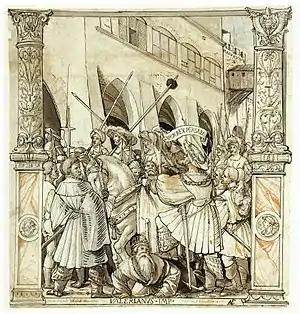260
Year 260 (CCLX) was a leap year starting on Sunday (link will display the full calendar) of the Julian calendar. At the time, it was known as the Year of the Consulship of Saecularis and Donatus (or, less frequently, year 1013 Ab urbe condita). The denomination 260 for this year has been used since the early medieval period, when the Anno Domini calendar era became the prevalent method in Europe for naming years.
| Millennium: | 1st millennium |
|---|---|
| Centuries: | |
| Decades: | |
| Years: |
| 260 by topic |
|---|
| Leaders |
| Categories |
|
| Gregorian calendar | 260 CCLX |
| Ab urbe condita | 1013 |
| Assyrian calendar | 5010 |
| Balinese saka calendar | 181–182 |
| Bengali calendar | −333 |
| Berber calendar | 1210 |
| Buddhist calendar | 804 |
| Burmese calendar | −378 |
| Byzantine calendar | 5768–5769 |
| Chinese calendar | 己卯年 (Earth Rabbit) 2956 or 2896 — to — 庚辰年 (Metal Dragon) 2957 or 2897 |
| Coptic calendar | −24 – −23 |
| Discordian calendar | 1426 |
| Ethiopian calendar | 252–253 |
| Hebrew calendar | 4020–4021 |
| Hindu calendars | |
| - Vikram Samvat | 316–317 |
| - Shaka Samvat | 181–182 |
| - Kali Yuga | 3360–3361 |
| Holocene calendar | 10260 |
| Iranian calendar | 362 BP – 361 BP |
| Islamic calendar | 373 BH – 372 BH |
| Javanese calendar | 139–140 |
| Julian calendar | 260 CCLX |
| Korean calendar | 2593 |
| Minguo calendar | 1652 before ROC 民前1652年 |
| Nanakshahi calendar | −1208 |
| Seleucid era | 571/572 AG |
| Thai solar calendar | 802–803 |
| Tibetan calendar | 阴土兔年 (female Earth-Rabbit) 386 or 5 or −767 — to — 阳金龙年 (male Iron-Dragon) 387 or 6 or −766 |

The humiliation of Emperor Valerian (Hans Holbein the Younger, ca. 1521)
Events
Roman Empire
- Battle of Edessa: With a large army, said to number 70,000 men, Valerianus attempts to drive the Persians back from Edessa. The Roman army is surrounded and most of its troops are killed or captured. Valerianus is taken prisoner for the remainder of his life.
- Shapur I sends Valerian to Bishapur and uses the captured Roman army for engineering plans. They construct the Band-e Kaisar (Bridge of Valerian).
- Gallienus becomes the sole emperor of Rome; during his reign the Pannonian governor Ingenuus revolts on the Danube.
- Gallienus evacuates the fortifications (limes) in the Agri Decumates (Germania Superior), covering the Black Forest area in the face of invading Alamanni.
- Gallienus establishes himself at Mediolanum (modern Milan); he reorganizes the army, supported by elite cavalry, and dispatches troops to the Rhine frontier.
- Postumus, Roman usurper, forms the Gallic Empire and protects the Rhine against an invasion of Germanic tribes.
- Saloninus, son of Gallienus, is proclaimed Augustus by his troops. Postumus besieges Cologne, where Silvanus is praetorian prefect and Roman ruler of Gaul.
- Postumus executes Saloninus and his adviser Silvanus after breaching the walls of Cologne. He is recognized as emperor and establishes his capital at Trier.
- Postumus wins over all the Roman provinces west of the Alps, including Gaul, Britain and Hispania.
- The Roman fort of Wiesbaden (Germany) is captured by the Alamanni.
- The Franks take control over the Scheldt estuary (approximate date).
Persia
- Persian king Shapur I destroys Caesarea Mazaca in Asia Minor.
China
Arts and sciences
- Earliest known date of chess.
Religion
- Pope Dionysius convenes a synod at Rome to demand an explanation from bishop Dionysius of Alexandria, who has been charged with separating the members of the Trinity as three distinct deities.
- Paul of Samosata becomes Patriarch of Antioch.
Births
- Eusebius of Caesarea (approximate)
Deaths
- June 2 – Cao Mao, Chinese emperor of the Cao Wei state (b. 241)
- July 2 – Empress Cao, Chinese empress of the Han dynasty (b. 197)
- Chen Tai, Chinese general of the Cao Wei state
- Saloninus, Roman emperor and son of Gallienus (b.242)
- Sun Liang, Chinese emperor of the Eastern Wu state (b. 243)
- Valerianus I, Roman emperor (approximate date)
References
This article is issued from Wikipedia. The text is licensed under Creative Commons - Attribution - Sharealike. Additional terms may apply for the media files.